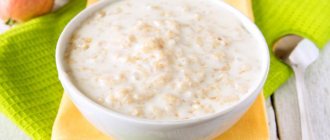Atmosphere
From early childhood, the child develops a culture of eating. You need to focus on the taste, smell, chew slowly and be distracted.
Older children can read fairy tales about porridge, show cartoons in which the characters eat porridge with pleasure (the fairy tale “Porridge from an Axe”, “A Pot of Porridge”, the cartoon “Masha + Porridge”, “How the Cossacks Cooked Kulesh..." but in no case at the table during lunch.
It rarely happens that a child completely refuses porridge - more often he does not like a certain type of porridge. For example, he may happily eat buckwheat porridge and turn his nose up at a plate of oatmeal.
If your baby categorically refuses porridge in any form, you should leave him alone for a week and then offer him a try again.
Photo: depositphotos
What to do if an infant does not want to eat porridge
At what age should porridge be introduced into a child’s diet? What types of cereals are best to start with? Cook it yourself or buy it at the store? Should I add milk, formula or just water? Today we asked pediatrician, consultant of the HealthMail.ru project Olesya Vladimirovna Butuzova about this and much more.
— Olesya Vladimirovna, how are porridge beneficial for a child’s body?
— Porridge is a nourishing complementary food that perfectly saturates the child and is a source of not only nutrients, but also vitamins and microelements. Porridge introduces protein into a child’s body—the building blocks for every rapidly growing cell.
— When should porridge be introduced into a baby’s complementary feeding?
- Porridge is recommended as a second complementary food, after vegetables, at 6-6.5 months. The exception is low birth weight babies with little weight gain. They are given the porridge first.
— In what order should different types of cereals be introduced into a child’s diet?
— It is best to start feeding cereals with buckwheat - a very healthy and at the same time hypoallergenic cereal. Next comes rice, and then corn and oatmeal. The exception is children with a tendency to constipation: they are advised to abstain from rice.
| Type of porridge | Introduction dates | Benefit | Adverse reactions |
| Buckwheat | 4-7 months |
Does not contain gluten and extremely rarely causes allergies. | May cause bloating |
| Rice | 4-7 months |
| May cause constipation |
| Corn | 5-7 months |
| A large amount of phosphorus in cereals with frequent consumption of porridge can cause leaching of calcium from bones and disorders of skeletal formation |
| Oatmeal | 5-7 months |
| Due to gluten content, it may cause adverse reactions |
— How can parents understand that a child does not want to eat porridge because his body is not yet ready for this product? Or maybe the baby is just being capricious?
— The body is ready when the gastrointestinal tract is “ripe.” Early introduction of cereals as complementary foods can lead to digestive problems. But you need to understand that a child may not like porridge and refuse it simply because he doesn’t like the taste. In this case, you should try a different type of porridge.
— What types of cereals do infants most often refuse and why?
— From corn or oatmeal: they have a sharper taste than buckwheat and rice. But I still emphasize that each child is an individual, so he may or may not like any type of porridge.
— Why do breastfed children most often refuse to eat porridge?
— Children love breast milk, and not everyone feels the need to try something new, because such feeding also provides psychological comfort for the child. And, of course, they simply may not like the consistency or taste of the porridge.
— Is it possible to completely eliminate porridge from a child’s diet? Is it possible to replace porridge with something if the child refuses to eat it?
— I still wouldn’t recommend excluding porridge. I would try to fantasize and look for ways to accustom my child to them. But I definitely wouldn’t insist, so as not to aggravate the problem. You can mix porridge with vegetable and fruit purees, this helps to introduce them even to those who don’t want to.
— For what reasons do one-year-old children refuse cereals? What to do if a one-year-old baby refuses to eat porridge?
- In this case, it is important to remember the main thing - you cannot insist, much less force! This creates a strong protest and eating disorders. Suggest and pause between sentences so that the child forgets about the first unsuccessful attempts. Add berries or fruits, or maybe vegetables if your child is a vegetable lover. Everything will work out!
Vegetables, berries and fruits help improve the taste of porridge. If the child categorically refuses cereals, you need to come up with a replacement for them. The protein component, for example, can be replaced with omelettes, steamed or baked in the oven.
— There is an opinion that the child should be allowed to get really hungry, increasing the break between meals to 4 hours. Does this method help to cope with porridge withdrawal and are such breaks harmful?
“I’m still in favor of focusing on the child’s feelings and desires.” Yes, when breastfeeding we feed on demand, and when introducing complementary foods we already create a schedule with regular meals. But I would not recommend creating additional gaps between feedings - the recommended five feedings a day provide just a break between meals of at least 4 hours.
— Is it possible to use games and cartoons to feed a child porridge?
- No, you definitely shouldn’t do this! Children enthusiastically watch cartoons - at the same time, you can “shove” any food into them. But this is fraught with eating disorders now and in the future. I wouldn't recommend this approach.
— Some parents are convinced that it is possible to increase the child’s appetite by reducing the portion of porridge. Does this method work?
- Why make a child feel hungry? This way he will wake up earlier and ask for food earlier. The child should be given the amount of porridge that he will eat; there is no need to artificially reduce the portion.
— Is it possible to give a child sweets after porridge, thus teaching him that he must eat porridge?
- I don't recommend this method. The only thing is that if you completely reject porridges, you can add fruit puree to them for taste (that is, replace sweets with fruits). But here’s an interesting story I can tell from my experience: I introduced broccoli puree to my child as his first complementary food, and he loved it so much that problems with porridge were solved not with fruit puree, but with vegetable puree.
— Can interest in porridge awaken without outside interference?
- Yes, sure! Just offer and, most importantly, don’t insist. Any tension in the introduction of complementary foods can lead to its denial by the child. There is no need to insist that the baby eat a new product; this may delay the introduction of porridge into the diet.
— Are there methods for teaching a child to regularly eat porridge? Does pedagogical complementary feeding help with this?
— I am for accustoming a child to new foods comfortably, without insisting or forcing. Offer, let try, experiment. You can also try complementary feeding - for this you need to adhere to proper nutrition yourself. Then the child will taste good, suitable porridge from the parent’s plate.
— What mistakes do parents most often make when trying to teach their child to eat porridge?
— Early or rapid introduction, insisting on porridge, introducing porridge prepared with milk as the first complementary food - these are the main mistakes that parents make.
— Does the container in which porridge is served to children matter?
- I think it does. Moreover, now there is a large number of dishes adapted for children, including in order to teach them how to eat independently.
— How can parents choose “their” cereals that the child will like without unnecessary stress?
- Just experiment. But extremely carefully. If your child doesn’t want to eat buckwheat, try rice, but with a quarter teaspoon, carefully observing his reaction. If you are not in a hurry to eat from a spoon, make the porridge a little thinner and give it from a bottle. The main thing is to always remember that there are recommendations from the pediatrician, and there are individual characteristics of the child, which are very important to focus on.
— Which cereals do children most often not eat: home-cooked or store-bought? How to choose the best instant baby porridge?
- In fact, everything is individual and rather depends on habit - if you give store-bought cereals, the child will get used to them, but if you offer cereals “of your own production,” then the baby will eat them without knowing any other taste. But as a pediatrician, I highly recommend ready-made instant, that is, instant, porridges. They are easier to digest and assimilate, their composition is as precise as possible and beneficial for the baby’s health.
— Do porridges made with goat’s milk and those made with cow’s milk taste different? Which cereals do children like best and why?
— To begin with, I would say that porridges made with goat milk, for example, MAMAKO® porridges, are better absorbed by the child’s body. As for the taste, goat milk porridges have a delicate creamy taste and kids really like them.
— What are the benefits of MAMAKO® baby porridge with goat milk?
— MAMAKO® baby porridges are a tasty and very healthy combination of cereals and goat milk. The porridges do not contain starch, GMOs, added vegetable oils or preservatives. And even little ones like it!
For 15 years now, as a pediatrician, I have been involved in the health of children and I know for sure that the condition of the gastrointestinal tract in adulthood depends on proper nutrition, including the correct introduction of complementary foods. Once again I want to say that porridge is a very healthy and tasty product for feeding babies. If you introduce them in a timely and careful manner, then this dish becomes one of the child’s favorites. And even if problems arise, they can be solved. The main thing is to act patiently and with love!
Pediatrician, author of books on children's health
Butuzova Olesya Vladimirovna
*The ideal food for an infant is mother's milk. WHO recommends exclusive breastfeeding for the first 6 months. MAMAKO® supports this recommendation. Before introducing new foods into your baby’s diet, consult a specialist.
Was this article helpful? Share it on social networks!
How to make a child eat? 17 unique secrets from personal practice.
I think many of us face this problem. When literally every spoonful of food has to be almost shoved into the child.
And then the question “how to get a child to eat?” becomes not at all idle, but practical.
I will share with you my extensive experience and reveal many of the secrets that I used myself.
I’ll say right away that it’s almost impossible to force a child to eat if he doesn’t want to!











